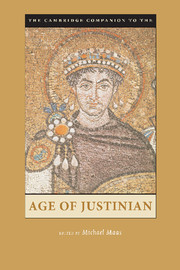Book contents
- Frontmatter
- Part 1 Structures and Ideologies of Empire
- Part 2 Religion and Philosophy
- 9 The Legacy of Chalcedon
- 10 Society and Community in the Christian East
- 11 Emperors and Popes in the Sixth Century
- 12 Christian Piety and Practice in the Sixth Century
- 13 Philosophy in the Age of Justinian
- Part 3 Literature and the Arts
- Part 4 Peoples and Communities
- Bibliography
- Index
- Plate Section 1
- Plate Section 2
12 - Christian Piety and Practice in the Sixth Century
from Part 2 - Religion and Philosophy
Published online by Cambridge University Press: 28 May 2006
- Frontmatter
- Part 1 Structures and Ideologies of Empire
- Part 2 Religion and Philosophy
- 9 The Legacy of Chalcedon
- 10 Society and Community in the Christian East
- 11 Emperors and Popes in the Sixth Century
- 12 Christian Piety and Practice in the Sixth Century
- 13 Philosophy in the Age of Justinian
- Part 3 Literature and the Arts
- Part 4 Peoples and Communities
- Bibliography
- Index
- Plate Section 1
- Plate Section 2
Summary
The sixth century represents a particularly dynamic period in the history of Christianity in the eastern Mediterranean, not merely for its articulation of ecclesiological divisions between those claiming adherence to the Council of Chalcedon and those rejecting it, but also for its impact on the development of Christian practices. A wide variety of written sources and material evidence - including histories, saints' lives, collections of miracle accounts, festal hymns, pilgrim’s diaries and souvenirs, magical paraphernalia, images, and architecture - attests to significant changes in modes of piety, the ways Christians expressed and engaged in their religious life. The evidence presented here challenges models for understanding religion through neat distinctions between clergy and laity, between elite and popular pieties, and between religion and magic. Many innovations in liturgical practice disseminated by church leaders led to new modes of Christian self-conception for all participants. At the same time evolving forms of “popular” devotion such as pilgrimage and the seeking of miracles gained popularity with emperor and peasant alike. Although parallel developments occurred among non-Chalcedonian Christians, this essay emphasizes Constantinople and neo-Chalcedonian Christianity.
- Type
- Chapter
- Information
- The Cambridge Companion to the Age of Justinian , pp. 291 - 315Publisher: Cambridge University PressPrint publication year: 2005
- 10
- Cited by

